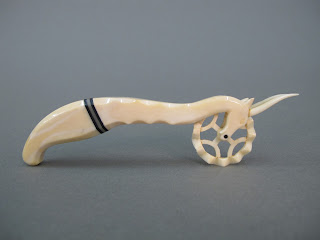2002 North Main Street
Santa Ana, California 92706
TEL: 714.567.3600
Crimped on these Jagger Seas
 |
|
Pie Crimper, c. 1890
Unknown artist (American); North America
Sperm whale ivory and wood; 4 5/8 x 3 1/2 x 6 in.
2011.25.15
Gift of Dr. and Mrs. Burton W. Fink
|
Pies are made all over the world in sizes ranging from large table pies to small palm-sized pies, and for every size twice as many flavors exist. With all the variations, bakers need a way of differentiating between pies. This is where crimping comes into play, allowing bakers to seal and secure the filling within the dough and use uniquely shaped tools to distinguish pie varietals. Crimping can be done by hand, with a fork, or as illustrated with today’s post, by using a wheeled-pie crimper colloquially referred to as a jagger by the whalebone carvers who once made them. In the 18th and 19thCenturies, out on the high seas, New England sailors doubling as scrimshaw artists honed their carvings into an art, and it was well known then that “the magnum opus of every scrimshander worth his name […] was his jagging-wheel.”
 |
| These mounted pie crimpers illustrate more run- of the mill designs. Gift of Dr. and Mrs. Burton W. Fink. 2011.25.32-.38. |
New England’s whaling population found carving crimpers to be an excellent way to pass time while out on the open sea, and the finer the craftsmanship of their crimpers, the better the rewards a sailor could reap upon his return to shore. Sometimes the incentive was purely monetary, such as for the annual crimping contest held in New Bedford, Massachusetts. Many times, however, crimpers were carved as a token of affection and fidelity for sweethearts back home. Whatever the rationale behind carving a crimper, with the months or years whalers had to carve out at sea, the only limitations to the complexity of these jaggers were the creativity and skill of the carver. The most elaborate examples further illustrate that the implement’s utilitarian function was not a priority. Openwork was standard fare for this classification of crimper: hearts and diamonds were created with empty space, dedications to loved ones carved as spokes of the jagging wheel, and ball in cage games inserted into handles. One delightfully effete jagger has six wheels of the same size and shape. Though it does not boast openwork or an excess number of jagging wheels, the Bowers Museum’s bird-shaped crimper sets itself apart with an interesting design point: the eyes of the bird are the axle holding the wheel in place. Details like this and feather texturing given to the wings by the crimper’s unknown artist show that almost every scrimshaw pie crimper was unique for one reason or another.
 |
|
Pie Crimper, 19th Century
Unknown artist (American); North America
Sperm whale ivory and baleen; 7 1/2 x 2 x 3/4 in.
2011.25.58
Gift of Dr. and Mrs. Burton W. Fink
|
It could be expected that crimpers were carved to resemble animals seen at sea, but speaking again to the creativity of the makers, and the perhaps surprising amount of nonfiction available to sailors, this is not necessarily the case. Bird designs, such as that of the Bowers’ crimper, could logically be numbered among the animals seen on the open ocean, but at least 139 unique bird species have been counted as jagging wheel decorations, not all of which would have been common sights close to shore. Furthermore, mythological animals also made for popular motifs. Though the horn is split in two to allow for the jagging wheel, another Bowers jagger features a unicorn. Hippocamps, fantastical half horse, half fish creatures, are perhaps more understandable as a motif.
Though they had the simple purpose of fluting and sealing the crusts of pies, crimpers represented so much more. With husbands leaving to whale for years on end, a jagging wheel could be one of the few items by which a wife had to remember her husband. They were precious, sentimental pieces, born of the same excess of time that turned rugged sailors into artisans. Often deeply expressive in their sentiment they are wholly at odds with their modern counterparts.
Text and images may be under copyright. Please contact Collection Department for permission to use. Information subject to change upon further research.


Comments